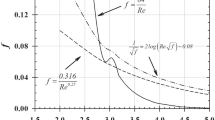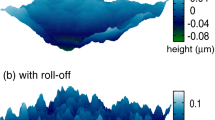Abstract
A mathematical model is constructed of the dependences of the coefficient of permeable-wall surface friction with heat-and-mass transfer on various factors (flow speed, parameter of equivalent sand roughness, plate thickness, gas-film lubrication, and others). The model is based on the results of research conducted using the polyfactorial experiment method. The key feature of this method is the polyfactorial approach to implementation of the experiment because it changes all the operating factors simultaneously point-by-point, rather than changing them in succession. The novel polyfactorial experiment design method enables us to select for experimentation the most informative combinations of values of the significant factors and to determine the number of experiments necessary and sufficient to obtain an analytical dependence of the surface friction coefficient with the required accuracy.
Similar content being viewed by others
References
Turbulentnye techeniya i teploperedacha (Turbulent Flows and Heat Transfer), Ed. Ling Tszyatszao, Moscow: Inostr. Literatura, 1963.
Shlikhting, G., Vozniknovenie turbulentnosti (Turbulence Appearance), Moscow: Inostr. Literatura, 1962.
Chen, P. and Tyson, G., Primenenie teorii turbulentnykh pyaten Emmonsa k obtekaniyu zatuplennykh tel (Application of the Theory of Turbulent Spots of Emmons to the Flow around of Blunted Bodies), Raketn. Tekh. Kosmonavt., 1971, no. 5, p. 63.
Barbin, R. and Johns, A., Turbulent Flow at the Beginning of a Smooth Tube, Trans. AEMS, Ser. D, Eng. Mech., 1963, no. 1, p. 34.
Sidnyaev, N.I. and Vilisova, N.T., Rukovodstvo k resheniyu zadach po teorii planirovaniya eksperimenta (A Guide to Solving Problems of the Theory of Experiment Designing), Moscow: Mos. Gos. Tekhn. Univ. N.E. Baumana, 2002.
Nalimov, V.V. and Chernova, N.A., Statisticheskie metody planirovanija ekstremal’nykh eksperimentov (Statistical Methods of Designing of Extreme Experiments), Moscow: Nauka, 1965.
Adler, Yu.P., Markova, E.V., and Granovskii, Yu.V., Planirovanie eksperimenta pri poiske optimal’nykh uslovii (Experiment Designing when Seeking for Optimum Solutions), Moscow: Nauka, 1976.
Spiridonov, A.A., Planirovanie eksperimenta pri issledovanii tekhnologicheskykh protsessov (Experiment designing when Investigating Production Processes), Moscow: Mashinostroenie, 1981.
Nalimov, V.V. and Golikova, T.I., Logicheskie osnovaniya planirovaniya eksperimenta (Logical Grounds of Experiment Designing), Moscow: Metallurgiya, 1980.
Pimenta, M.M., Moffat, R.J., and Kays, W.M., The Turbulent Boundary Layer: an Experimental Study of the Transport of Momentum and Heat with the Effect of Roughness, Rept. N HMT-21, Stanford University, Dept. of Mech. Eng., 1975.
Author information
Authors and Affiliations
Corresponding author
Additional information
Original Russian Text © N.I. Sidnyaev, 2009, published in Trenie i Iznos, 2009, Vol. 30, No. 2, pp. 186–191.
Here, surface friction is used to refer to resistance to the gas flow streaming around a solid body.
About this article
Cite this article
Sidnyaev, N.I. Assessment of the parameters of surface friction with the methods of the experiment design theory. J. Frict. Wear 30, 137–141 (2009). https://doi.org/10.3103/S106836660902010X
Received:
Published:
Issue Date:
DOI: https://doi.org/10.3103/S106836660902010X




